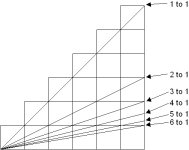JOR_EL
Silver Member
- Joined
- Apr 29, 2001
- Messages
- 242
- Tractor
- JD4700 HST w/mods. SUPERBABY
Re: Safety Tips - Tractor Overturn Hazards
John,
Just a comment while you wait for Rick's reply; I'll be posting some weight/balance studies that I did on my rig with various implement combos. Front/rear axle loadings, longitudinal c.g.'s for each, ...and some info on figuring such. It will be some time before I have the post ready.
Meanwhile;
Re. vertical c.g.; I saw a reference somewhere to it being about 10-12" higher than the rear axle, for a "normal' tractor WITH ANY LOADS HELD LOW.
My "guesstimate" is that this is fairly accurate, and using it and the tire-track width of your tractor will let you diagram the "theoretical " sideways roll-over angle. This assumes the tractor does not slip sideways, gaining momentum that will tip the tractor when something STOPS the slide, and that no soft dirt or holes(on the downhill side)/bumps(on the uphill side) tilt the tractor further. I t also assumes adequate tire strength/air-pressure so that the now-more heavily loaded "downhill" tires do not distort, lowering that side and causing more tilt.
These(and other) considerations are the reasons that the "theoretical" limit has to be taken with a very big grain-of-salt, when considering how steep a slope to attempt to operate on.
But, ...it IS interesting to picture a tractor mowing sideways on an "ideal" surface and a slope of 40 degrees or so. Interesting AND SCARY! DEFINITELY NOT-RECOMMENDED!
Front/rear- a tractor w/o front ballast is MUCH more likely to flip over BACKWARDS, than forwards. The caution to "TOW only from the drawbar (i.e. from BELOW the rear axle)" should ALWAYS be heeded! This tends to "lever" the front end into-the-ground.
More when I post the weight study.
HTH,
Larry
John,
Just a comment while you wait for Rick's reply; I'll be posting some weight/balance studies that I did on my rig with various implement combos. Front/rear axle loadings, longitudinal c.g.'s for each, ...and some info on figuring such. It will be some time before I have the post ready.
Meanwhile;
Re. vertical c.g.; I saw a reference somewhere to it being about 10-12" higher than the rear axle, for a "normal' tractor WITH ANY LOADS HELD LOW.
My "guesstimate" is that this is fairly accurate, and using it and the tire-track width of your tractor will let you diagram the "theoretical " sideways roll-over angle. This assumes the tractor does not slip sideways, gaining momentum that will tip the tractor when something STOPS the slide, and that no soft dirt or holes(on the downhill side)/bumps(on the uphill side) tilt the tractor further. I t also assumes adequate tire strength/air-pressure so that the now-more heavily loaded "downhill" tires do not distort, lowering that side and causing more tilt.
These(and other) considerations are the reasons that the "theoretical" limit has to be taken with a very big grain-of-salt, when considering how steep a slope to attempt to operate on.
But, ...it IS interesting to picture a tractor mowing sideways on an "ideal" surface and a slope of 40 degrees or so. Interesting AND SCARY! DEFINITELY NOT-RECOMMENDED!
Front/rear- a tractor w/o front ballast is MUCH more likely to flip over BACKWARDS, than forwards. The caution to "TOW only from the drawbar (i.e. from BELOW the rear axle)" should ALWAYS be heeded! This tends to "lever" the front end into-the-ground.
More when I post the weight study.
HTH,
Larry




